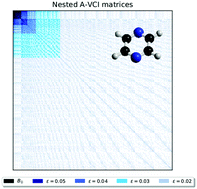Using computed infrared intensities for the reduction of vibrational configuration interaction bases†
Abstract
The Adaptive Vibrational Configuration Interaction (A-VCI) algorithm is an iterative process that computes the anharmonic spectrum of a molecule using nested bases to discretize the Hamiltonian operator. For large molecular systems, the size of the discretization space and the computation time quickly become prohibitive. It is therefore necessary to develop new methods to further limit the number of basis functions. Most of the time, the interpretation of an experimental infrared spectrum does not require the calculation of all eigenvalues but only those corresponding to vibrational states with significant intensity. In this paper, a technique that uses infrared intensities is introduced to select a subset of eigenvalues to be precisely calculated. Thus, we build smaller nested bases and reduce both the memory footprint and the computational time. We validate the advantages of this new approach on a well-studied 7-atom molecular system (C2H4O), and we apply it on a larger 10-atom molecule (C4H4N2).



 Please wait while we load your content...
Please wait while we load your content...